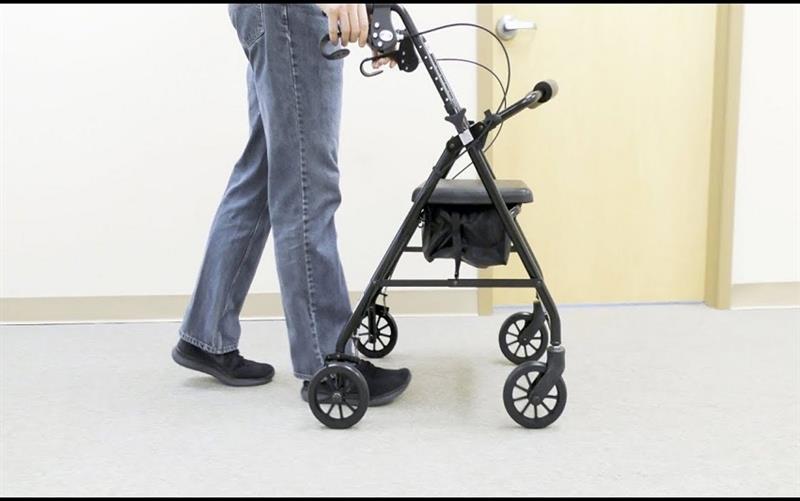
A mobility device can make daily activities simpler for your patients if they experience fatigue when walking longer distances, have a condition that affects their balance, gait, or leg strength, or are recuperating from a lower limb injury or surgery.
Patients seek out physicians and therapists with the intention of continuing to be autonomous and active. But how can they pick the best assistive device? How can patients choose which equipment best suits their lifestyle when the terms "walker" and "rollator" are frequently used interchangeably? We're here to assist you! Give your patients a copy of this information to assist them select a mobility aid that best suits their needs.
Describe Walker
A steady mobility aid is a walker. There are varieties of walkers with and without wheels. They typically have a plainer appearance than rollators.
People with balance issues can support themselves steadily with non-wheeled walkers. Walkers are not a good option for persons with weak arms because you have to pick them up and move them ahead before you can take another step.
In addition to providing support, wheeled walkers contain two front wheels, which increase their manoeuvrability and ease of movement.
- The walker's legs lack wheels.
- The walker can advance with the help of accessories.
- Before moving forward, Walker must be raised and lowered.
- Can support a portion of your body weight
- Possesses no seat
- Walkers can be used to assist with walking balance.
- Some walkers have two wheels up front, making them hybrids that fall somewhere between a walker and a rollator.
Describe Rollators
A more portable stability aid is a rollator. There are three-wheel and four-wheel variations of rollators. They are a little more fashionable than walkers and come in a range of colours. However, rollators are frequently heavier than walkers (about 25 lbs. vs. 8 lbs.) due to the wheels and brake system, which is a crucial factor to take into account if you'll be carrying it and lack arm strength.
A rollator with three wheels can turn sharply, fits in tighter areas, and is more manoeuvrable. Although they lack a seat due to their construction, they are lighter than four-wheeled versions.
A traditional rollator with four wheels provides stability and simple manoeuvrability. Walking speed and mobility are improved by rollators. Rollators may not be the greatest alternative for all users because of the steering and simple hand brake operation required due to their four wheels.
- Rollators are also known as wheeled walkers, rolling walkers, and medical rollators.
- The rollator's legs all have wheels.
- The rollator does not need to be lifted in order to go forward because of its wheels.
- Should not support body weight because doing so could cause falls
- There is a seat on rollators, and some feature removable backs to help users balance while seated.
- While walking, rollators cannot be utilised for balance.
- Rollators from Medline Guardian are made especially for tall people over 5' 11" and up to 6' 3".
Rolling Hybrid Walker
- Hybrid rolling walkers can be lifted, with the walker's weight resting on the front wheels, and then slid forward. They have two rear legs and two front wheels.
- Although they have two wheels that can move swiftly, rolling walkers can be used to balance and support a little amount of weight.
- Seats are typically absent from hybrid rolling walkers.
- Smaller floor plans can benefit from the usage of rolling walkers rather than full-scale rollators because of their size.
When to Use a Rollator or Walker
When ought a walker to be used?
The best users for walkers are those who require steady support and go more slowly. A walker can be the best option for you if you are mobile enough to walk rather than use a wheelchair but find it difficult to go from your bedroom to your bathroom. People who are recovering from hip or knee replacement surgery and are unable to bear weight on one leg might consider using a walker.
When is a rollator appropriate to use?
The best rollators are for people who can walk but simply require a little assistance with stability and balance. Rollators facilitate a natural stride and let you move more quickly. The rollator's user should be able to control its direction and apply the hand brakes as necessary. Most rollators have a seat so you can rest whenever you need to.
Choosing the Right Rollator or Walker
What Needs Do You Have?
Your demands will determine whether a walker or rollator is best for you.
Since all four legs are planted on the ground, a normal walker provides more stability. They are therefore perfect for people who struggle with balance, feel weak while standing, or need a solid, unmoving support to walk. Due to the poor walking speed and significant energy expended when lifting the walker, it is best suited for indoor use and shorter distances.
A two-wheel walker helps you to walk with a more natural gait but providing less stability and support than a regular walker.
If you can balance yourself but need frequent breaks, better navigation, more outside excursions, or assistance with shopping or medical needs, a rollator can be your best option. If you have trouble lifting a standard walker, this is an excellent alternative.